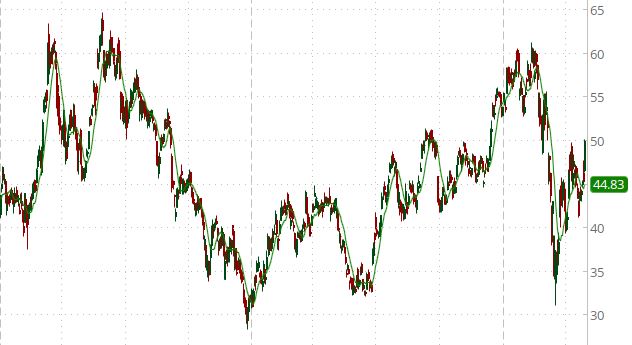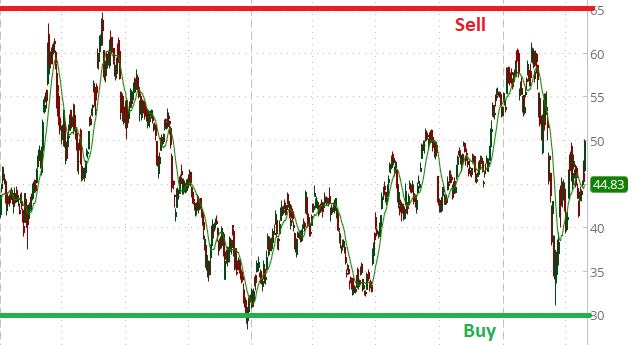Yes, you CAN get paid to wait!
This is the third in a series of posts on options. This series will help you to understand options contracts, their strengths, weaknesses, and risks. Most importantly, this series will make you a more successful investor.
To go to the first post on options, click here.
Before we get into the meat of learning options trading, I want to whet your appetite with another example of how options trading can boost your investing returns.
It is totally possible to earn income on stocks you already own or you want to own in the future.
Take a look at this chart for the microchip company Micron Technology:

As you can see, Micron has had quite turbulent action over the last 3+ years. Its price has swung between $60 and $30/share multiple times in this relatively short period. For day traders that may be a great opportunity. However, most of us with day jobs should not be playing that game.
Think about the person who has followed the common advice – buy and hold. An investor who bought shares in January of 2017 has watched their investment both increase AND decrease by 50% twice in three years. To make matters worse, they are now trading at around the same price as they were 3 years prior. In other words, a $4000 investment turned into $6000, $2000, $6000, $2000, and now is sitting right at $4000 again. Talk about an emotional roller coaster, and a terrible opportunity for second guessing yourself.
Micron is not a company that pays dividends, so current owners have nothing to show for their loyalty.
Getting Paid to Wait
But NOT the wise options trader. He knows how to generate income on his investments even without a dividend. We’ll call him Rob in this example. The values in this article are accurate according the Think or Swim “Thinkback” feature.
Imagine Rob owns 100 shares of Micron. He has decided he would be happy to sell them at $65. If Micron ever fell below $30, he would be glad to buy even more.

In November of 2017, Micron completed a bull run from $28 in August to a high of $49. Rob, ecstatic with this increase in his portfolio, has also decided to collect some income by selling a covered call. He has chosen the $65 call option which expires in January of 2020. Remember, the person who sold a call has entered an agreement to sell shares at a certain price ($65) for a period of time (anytime from now until January 2020). Rob’s trade is a ‘covered’ call because he owns 100 shares, enough to satisfy the contract.
In exchange for agreeing to sell his shares for $65, he collects a payment (called the ‘premium’) of $860!
How does this make sense?
Let’s take a moment to consider this carefully. Shares of Micron were trading for $49 that day. Rob still has complete ownership of his shares, and now he has received $860 that he keeps regardless of what happens to the option. In exchange for this payment, he is now obligated to sell his shares at $65 – something he already decided he would be happy to do! Further, Rob still benefits from the increase in price of the shares from $49 to $65, a 33% increase.
What is Rob’s risk here? His primary risk is that shares of Micron will increase far above $65 he misses out on any further price gains. For instance, if Micron trades at $100/share before his contract expires, Rob would still have to sell them for $65.
A Bear Attack!
The good times did not last, and Micron shares fell to a low of $37 on Feb. 9, 2018. On this day, Rob decides to buy back his contract for ~$472, locking in a profit of $388.
But he wasn’t done – not yet!
Rob has now decided to sell a cash covered put. In a put option, the seller agrees to BUY stocks at a specific price. For this trade, Rob sells the $25 put that expires in January 2020. He is now obligated to buy Micron shares for $25 if the holder of the contract chooses. Rob’s compensation is another premium of $200.
Rob has again been paid to do something he already wanted to do – this time to buy Micron at less than $30. If Micron never trades that low prior to the contract expiration in January 2020, he keeps the $200 and the contract expires worthless.
And what about the risk, you might ask? If the price of Micron falls below $25, Rob would still be on the hook for the full $25/share. The worst-case scenario is the shares fall to $0, which means his loss would be ($25-0)*100 = $2500. While possible, that is extremely unlikely. If the shares fall to $10 and the contract is assigned his loss would be ($25-10)*100 = $1500. He would still keep the $200 premium, and now he owns 100 more shares of Micron for a price he was willing to pay.
Let the Good Times Roll!
Fortunately, the bear did not last long and Micron went on another tear up to ~$60 on March 12, 2018. Rob again sold the January $65 covered call – this time for an eye popping $1367! He also bought back the put contract for $118, locking in $82 of profit from his trade just one month earlier.
I completed a sampling of potential trades Rob could have completed from late 2017 to 2020 and charted them below. A number in parenthesis is negative, which means he has bought back the contract he previously sold.


In summary:
- Rob still owns all of his shares of Micron
- He has pocketed an extra $3103
- He is free to continue making similar trades indefinitely
This outcome is made even more striking when compared against the investor who simply relied on a buy and hold strategy. That investor has earned no dividend, no options premiums, and his shares have not increased in value despite wild price swings.
Take Home – Options Pay!
In this hypothetical example, Rob has managed to add a nice amount of profit performing the exact same trades repeatedly. Obviously, his timing is impeccable – this is the benefit of hindsight. For those of us looking to use this strategy now, we will not be able to time the market perfectly. However, a prepared and wise investor could generate similar success with this strategy. The key is planning. Notice how Rob managed his risk by only engaging in options contracts that fit with his overall plan – buying a company he loved at less than $30 and selling at $65.
If you have any questions or comments about this material, please place it in the comment box below! I would love for these posts to be an interactive classroom for everyone.
Sign up for my monthly newsletter and receive all the latest updates and teaching from LWW.
Let’s Live Wealthy and Wise!
